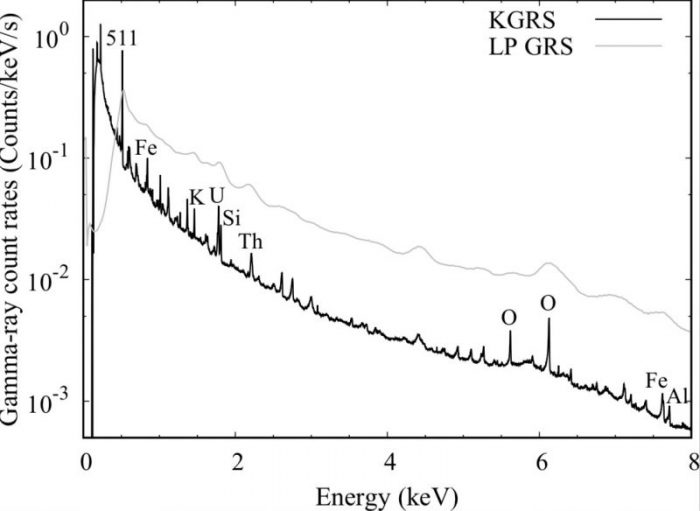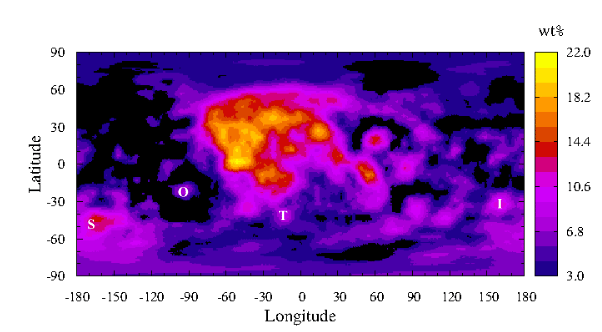
The moon is considered to have experienced a magma ocean, with whole-body melting. Differentiation and crystallization of the melt formed today’s crustal Moon. Major elemental abundances on the lunar surface provide geological constraints not only on today’s crustal and mantle compositions but also on the initial composition of the magma ocean and its history of evolution.
In particular, iron abundance largely varies in the process of crystallization of magma oceans. We have obtained a lunar iron global map by the observation results of the Kaguya Gamma-Ray Spectrometer (KGRS).
Gamma-ray spectroscopy is one unique technique to directly measure elemental abundances. One of the characteristic features of KGRS is an excellent energy resolution. The energy resolution enables accurate derivation of elemental abundances by peak fitting analysis of the complex gamma-ray spectrum. A comparison of energy spectra obtained by the KGRS and GRS onboard previous mission Lunar Prospector is shown in Fig. 1.

Figure 1. Comparison of energy spectra obtained by KGRS and Lunar Prospector GRS. A definitive difference in energy resolution is visible. Some major gamma-ray lines are assigned to their elements Note that the vertical axis is in arranged to avoid overlapping. Credit: Masayuki Naito
Iron abundance obtained by the KGRS generally becomes low in the north farside region and high in the nearside region, as shown in Fig. 2. It shows a very low detection limit of ~3-4 wt% FeO, while the gamma-ray counts drop below detection limit at low iron regions. Pixels in such regions are filled in black. This lower limit value is improved since that of Lunar Prospector GRS and now is over 4 wt%. The use of KGRS high-energy resolution datasets allows for the precise measurement of iron with high accuracy. On the other hand, the two iron abundance distributions show good agreement at regions with moderate-high iron abundance (> 6 wt%). Therefore, we have paid attention to some geologic features with low-moderate iron abundances.

Figure 2. Lunar FeO wt% map obtained by the KGRS. The pixels with values below the detection limits are filled in black. Labels indicate geologic features mentioned in the text (I: Mare Ingenii, O: Mare Orieltale, S: South Pole-Aitken basin and T: Tycho crater) Credit: Naito et al., 2018, https://linkinghub.elsevier.com/retrieve/pii/S0019103517301392, republished with permission from Elsevier.
Iron abundances at such regions provide some geologic implications which have not been seen in previous research. Typically high abundances of iron at Mare Ingenii and around the central depression of the South Pole-Aitken (SPA) basin are visible. It was found that the eruption of basalt containing a lot of iron occurred as a result of the Ingenii basin impact at the thinning crust by the previous impact of the South Pole-Aitken basin. These facts may imply some evolutional histories on the lunar farside which should be discussed by combining other elemental distributions in this region.
High iron abundance has been observed at Mare Orientale, although it falls below the detection limit at the multi-rings of the basin. These results support the basaltic composition at the mare region and materials dominated by anorthosite with very low iron content at the multi-ring region. On the other hand, Orientale’s impact ejecta with basaltic materials is not present, although a previous gamma-ray observation by the Chang’E-2 mission proposed the ejecta. It may be a miss-detection due to typical backgrounds of their detector.
The KGRS iron map shows 8-9 wt% FeO at Tycho crater, which was not observed by the Lunar Prospector GRS. This content aligns with the Apollo16’s returned sample ascribed to the Tycho impact ejecta. The Tycho crater is supposed to be composed of mafic materials originated by the impact melt.
These findings are described in the article entitled Iron distribution of the Moon observed by the Kaguya gamma-ray spectrometer: Geological implications for the South Pole-Aitken basin, the Orientale basin, and the Tycho crater, recently published in the journal Icarus. This work was conducted by Masayuki Naito, Nobuyuki Hasebe, Hiroshi Nagaoka and Eido Shibamura from Waseda University, Makiko Ohtake from Japan Aerospace Exploration Agency, Kyeong Ja Kim from Korea Institute of Geoscience and Mineral Resources, Christian Wöhler from the Dortmund University of Technology, and Alexey A. Berexhnoy from Moscow State University.









